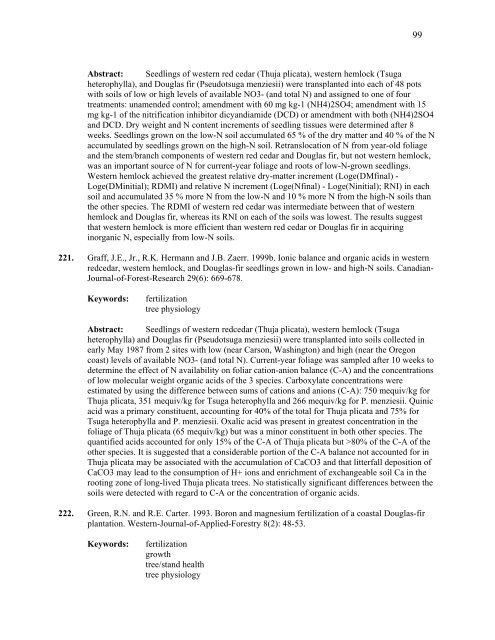IntensIve sIlvIculture - Forest Science Labs - Research Network ...
IntensIve sIlvIculture - Forest Science Labs - Research Network ...
IntensIve sIlvIculture - Forest Science Labs - Research Network ...
Create successful ePaper yourself
Turn your PDF publications into a flip-book with our unique Google optimized e-Paper software.
Abstract: Seedlings of western red cedar (Thuja plicata), western hemlock (Tsuga<br />
heterophylla), and Douglas fir (Pseudotsuga menziesii) were transplanted into each of 48 pots<br />
with soils of low or high levels of available NO3- (and total N) and assigned to one of four<br />
treatments: unamended control; amendment with 60 mg kg-1 (NH4)2SO4; amendment with 15<br />
mg kg-1 of the nitrification inhibitor dicyandiamide (DCD) or amendment with both (NH4)2SO4<br />
and DCD. Dry weight and N content increments of seedling tissues were determined after 8<br />
weeks. Seedlings grown on the low-N soil accumulated 65 % of the dry matter and 40 % of the N<br />
accumulated by seedlings grown on the high-N soil. Retranslocation of N from year-old foliage<br />
and the stem/branch components of western red cedar and Douglas fir, but not western hemlock,<br />
was an important source of N for current-year foliage and roots of low-N-grown seedlings.<br />
Western hemlock achieved the greatest relative dry-matter increment (Loge(DMfinal) -<br />
Loge(DMinitial); RDMI) and relative N increment (Loge(Nfinal) - Loge(Ninitial); RNI) in each<br />
soil and accumulated 35 % more N from the low-N and 10 % more N from the high-N soils than<br />
the other species. The RDMI of western red cedar was intermediate between that of western<br />
hemlock and Douglas fir, whereas its RNI on each of the soils was lowest. The results suggest<br />
that western hemlock is more efficient than western red cedar or Douglas fir in acquiring<br />
inorganic N, especially from low-N soils.<br />
221. Graff, J.E., Jr., R.K. Hermann and J.B. Zaerr. 1999b. Ionic balance and organic acids in western<br />
redcedar, western hemlock, and Douglas-fir seedlings grown in low- and high-N soils. Canadian-<br />
Journal-of-<strong>Forest</strong>-<strong>Research</strong> 29(6): 669-678.<br />
Keywords: fertilization<br />
tree physiology<br />
Abstract: Seedlings of western redcedar (Thuja plicata), western hemlock (Tsuga<br />
heterophylla) and Douglas fir (Pseudotsuga menziesii) were transplanted into soils collected in<br />
early May 1987 from 2 sites with low (near Carson, Washington) and high (near the Oregon<br />
coast) levels of available NO3- (and total N). Current-year foliage was sampled after 10 weeks to<br />
determine the effect of N availability on foliar cation-anion balance (C-A) and the concentrations<br />
of low molecular weight organic acids of the 3 species. Carboxylate concentrations were<br />
estimated by using the difference between sums of cations and anions (C-A): 750 mequiv/kg for<br />
Thuja plicata, 351 mequiv/kg for Tsuga heterophylla and 266 mequiv/kg for P. menziesii. Quinic<br />
acid was a primary constituent, accounting for 40% of the total for Thuja plicata and 75% for<br />
Tsuga heterophylla and P. menziesii. Oxalic acid was present in greatest concentration in the<br />
foliage of Thuja plicata (65 mequiv/kg) but was a minor constituent in both other species. The<br />
quantified acids accounted for only 15% of the C-A of Thuja plicata but >80% of the C-A of the<br />
other species. It is suggested that a considerable portion of the C-A balance not accounted for in<br />
Thuja plicata may be associated with the accumulation of CaCO3 and that litterfall deposition of<br />
CaCO3 may lead to the consumption of H+ ions and enrichment of exchangeable soil Ca in the<br />
rooting zone of long-lived Thuja plicata trees. No statistically significant differences between the<br />
soils were detected with regard to C-A or the concentration of organic acids.<br />
222. Green, R.N. and R.E. Carter. 1993. Boron and magnesium fertilization of a coastal Douglas-fir<br />
plantation. Western-Journal-of-Applied-<strong>Forest</strong>ry 8(2): 48-53.<br />
Keywords: fertilization<br />
growth<br />
tree/stand health<br />
tree physiology<br />
99
















